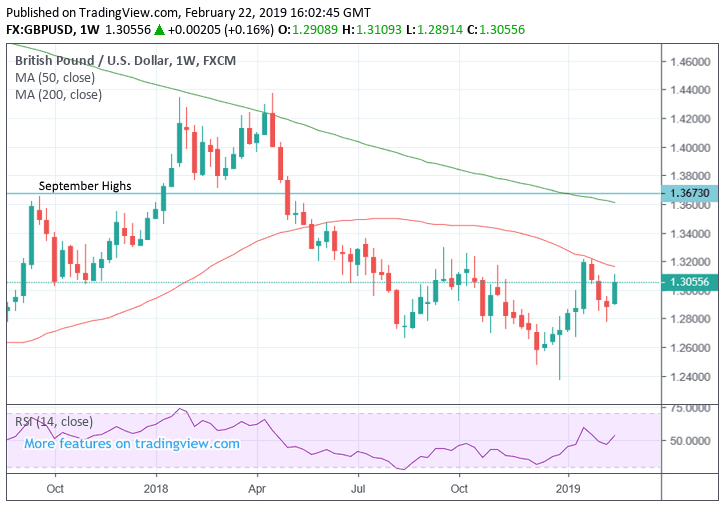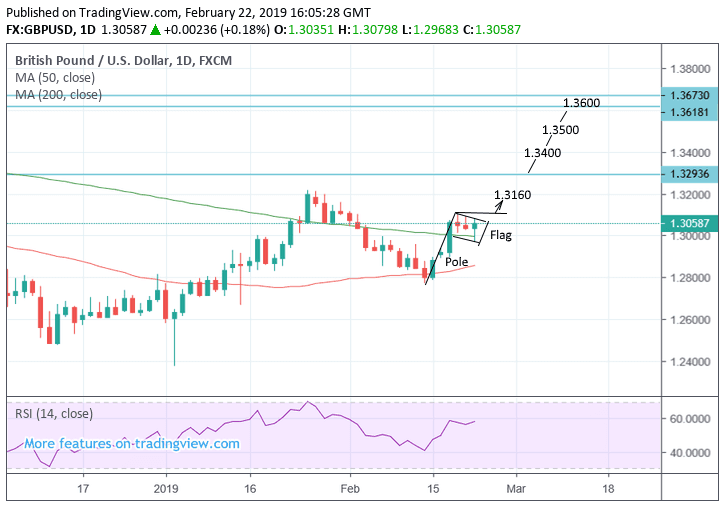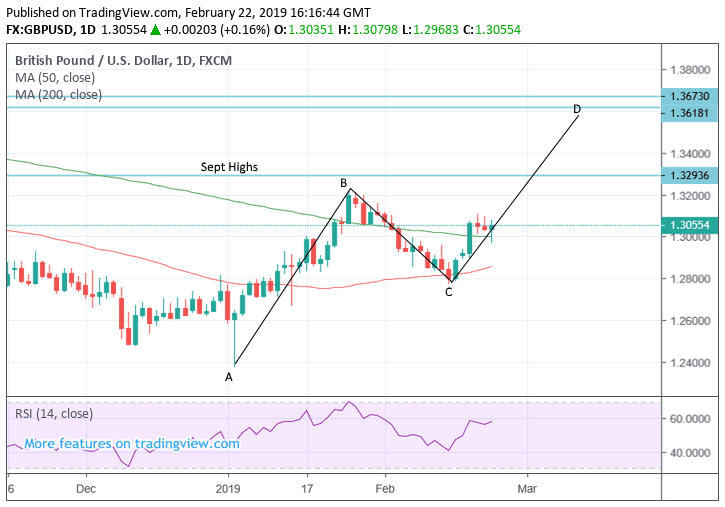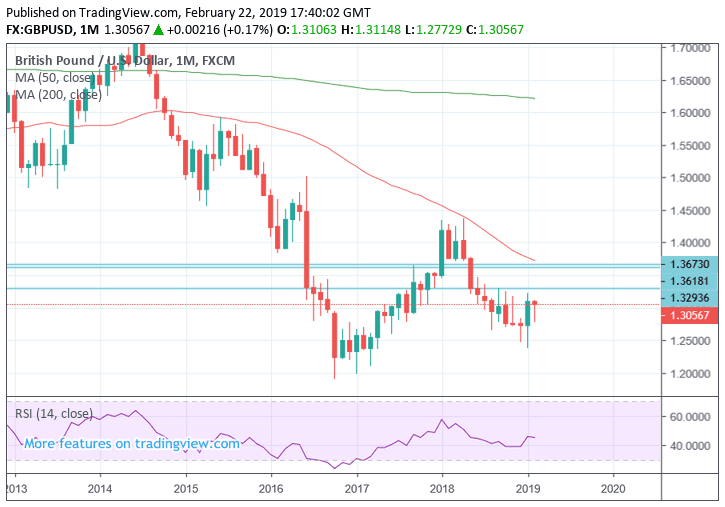Pound-to-Dollar Rate 5-Day Forecast: Bullish Technical Patterns Suggest More Upside

Image © jcomp, Adobe Stock
- GBP/USD forms several bullish patterns
- Break above 1.31 highs would open the way higher
- Sterling to be driven by Brexit votes; Dollar by multiple factors
The Pound is poised to make further gains against the U.S. Dollar from a technical basis with favourable chart setups being observed. However, an important week for Brexit politics and a slew of data out of the U.S. economy could trigger unexpected shifts in the GBP/USD exchange rate.
The Pound-to-Dollar exchange rate is trading at 1.3055 at the start of the new week having risen 1.35% from the week before.
The pair has been rising largely on the improved performance in Pound Sterling coming from expectations that any deal Theresa May presents to Parliament may in fact have more chance of winning the approval of MP’s than was previously thought, and she was seriously considering asking for more time from the European Union to pass the necessary legislation to ensure a managed Brexit, therefore, diminishing fears of a cliff-edge Brexit on March 29.
From a technical perspective, GBP/USD has turned sharply higher after bottoming at the February 14 lows.
The possible bullish wedge pattern which formed during the decline from the January 25 highs actually broke out higher as we suspected it might. It has since rallied up steeply and will probably continue rallying.
The pair has now also probably formed a bullish flag pattern. The first part of the bull flag consists of the rally up from the February 14 lows, in what analysts call the ‘pole’. The second part is the gentle pull-back which began after the Feb 20 peak and is the ‘flag’ part of the pattern. The pull-back my have further to go as flags can continue consolidating for some time.
A break above the 1.3109 flag highs could provide confirmation of more upside to the next target at 1.3160 - possibly even higher, up to a potential maximum of 1.3290.
The reason we fear it may not reach all the way is due to the location of the 50-week moving average (MA) which is sitting in the way of further gains at 1.3166. That explains why we have set the initial upside target at 1.3160.
If the pair can break clearly above the 50-week MA, confirmed by a move above the September highs, it would suggest a continuation higher to the next target at 1.34, followed by targets at 1.35 and 1.36.
GBP/USD looks like it is forming an ABCD pattern, which also has bullish connotations. ABCD’s are three wave zig-zag patterns in which waves A-B and C-D are of a similar or the same length. If price action really is forming one of these patterns it suggests substantial further upside to a hypothetical target at around 1.36.
GBP/USD has also formed a bullish key reversal pattern on the monthly chart - a further sign it could extend higher eventually. Key reversals occur at the end of trends when the exchange rate moves to a new low and then rises up and closes above the previous period’s high. The strong turnaround in the space of a month is seen as indicative of a major trend-changing shift in sentiment.
Time to move your money? Get 3-5% more currency than your bank would offer by using the services of foreign exchange specialists at RationalFX. A specialist broker can deliver you an exchange rate closer to the real market rate, thereby saving you substantial quantities of currency. Find out more here.
* Advertisement
The Dollar: What to Watch this Week
It is likely to be a busy week for the U.S. Dollar as a large number of important data releases from the U.S, including ISM Manufacturing, the PCE inflation gauge and annualised GDP are scheduled for release, whilst broader geopolitical drivers may also influence the currency as the March 1 deadline for the imposition of higher tariffs on Chinese imports is met on Friday.
The testimony of the head of the chairman of the Federal Reserve (Fed), Jerome Powell, to the Senate economic committee rounds off the many factors which could move the currency during the week.
Annualised GDP, or yearly growth, is expected to have slowed down to only 2.4% from 3.4% previously when 4th quarter figures are released at 14.30 GMT on Friday. On a quarterly basis growth is forecast to have risen by 1.7% in the final quarter, following a 1.5% rise in Q3. Slower-than-expected growth would be negative for the Dollar as it curtain inbound investment flows.
The Dollar is at risk of volatility when Fed chair Powell is questioned on the economy and Fed policy by senators during the week, starting Tuesday. If he continues to endorse a neutral, data-driven stance, the Dollar could dip, if he becomes more bearish and highlights further risks to the economy it could weaken.
PCE, short for ‘personal consumption expenditure’, is a key inflation metric and the Fed's preferred gauge. It is forecast to slow to 0.0% in December from 0.1% in the previous month when it is released at 14.30 on Friday. On a yearly basis is it forecast to show a 1.7% rise compared to a year ago from 1.8% previously. Any unexpected declines are likely to hit the Dollar, especially given the Fed's avowed data driven stance.
Finally, on the data front there is ISM manufacturing, out at 16.00 on Friday, which is forecast to slide to 55.9 from 56.6 in February from the previous month. It is important because it is so timely.
Trade talks between the U.S and China and the approach of the March 1 deadline for increasing tariffs on Chinese imports from 10% to 25% is another geopolitical factor which could impact on the Dollar.
If higher tariffs are enforced the Dollar will probably rise due to an increase in safe-haven flows, but this worst case scenario is on balance is unlikely and an 11th hour agreement or delay is more likely, which would weigh on the greenback.
The Pound: What to Watch this Week
Brexit focus returns to Westminster this week with the Prime Minister due to make a statement in Parliament on Tuesday and an amendable motion on Brexit is up for debate on Wednesday.
The amendment to look out for is the Cooper/Letwin amendment which if passed (and a linked Bill adopted), would result in the government being directed to request an extension to the Article 50 process, should it not get a deal through Parliament by 13 March.
For Sterling the passing of such a bill makes a 'no deal' Brexit less likely on March 29, and therefore its successful passage would be seen as a positive for the currency.
However, recall a similar amendment proposed by Cooper in January failed; therefore parliamentarians might still be erring on the side of allowing May the freedom to strike concessions from the EU before voting for such an amendment.
Last week Chancellor of the Exchequer Philip Hammond said there was the chance a meaningful vote on the deal itself might actually take place this week; for this to happen some kind of concessions will need to have been secured from Brussels.
If a vote on the deal is brought forward this could indeed be a momentus week for Sterling: If the deal passes we would expect a decent rally in the Pound, if it failed, expect a surge in uncertainty and a decline in the Pound.
“If the prime minister, Theresa May, manages to secure legal assurances from the EU on the Irish backstop, there will likely be a meaningful vote on the revised deal. But if UK-EU negotiations have not been completed by then, MPs could simply vote on an amendable motion on how to proceed next with Brexit. The latter carries the risk of Parliament voting to take control of the Brexit process, possibly forcing the government to extend Article 50, if Mrs. May has nothing to show from the latest round of talks with Brussels. Either way, the pound appears to be headed for more volatility.” Says Raffi Boyadjian, a currency analyst at XM.com.
Another key release for the UK currency, is the IHS Markit Manufacturing PMI for February, which is a survey-based activity indicator. This is out at 10.30 GMT on Friday and is forecast to show a drop to 52.0 from 52.8 in the previous month of January. PMI's are important leading indicators for the economy.
The Gfk Consumer Confidence survey is out at 1.01 early on Thursday morning and is forecast to show a -15 result from -14 previously - mainly as the mood sours over Brexit. An even sharper-than-predicted fall in the Gfk could well have negative repercussions for Sterling since declines in sentiment indicators often precede falls in the real economy.
Time to move your money? Get 3-5% more currency than your bank would offer by using the services of foreign exchange specialists at RationalFX. A specialist broker can deliver you an exchange rate closer to the real market rate, thereby saving you substantial quantities of currency. Find out more here.
* Advertisement








